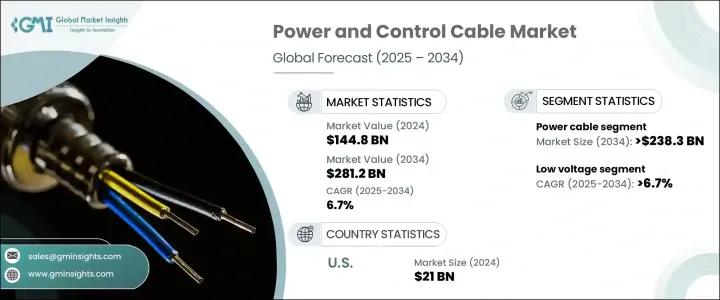
세계의 전력 및 제어 케이블 시장은 2024년에 1,448억 달러에 이르렀으며, 2025-2034년 연평균 복합 성장률(CAGR) 6.7%로 성장할 것으로 예측됩니다.
이 시장은 산업, 상업, 유틸리티의 각 분야 수요 증가에 의해 강력한 성장을 이루고 있습니다. 세계의 인프라 개발 추진, 급속한 도시화, 효율적인 배전에 대한 요구 고조가, 시장 확대에 박차를 가하고 있습니다. 세계 각국 정부는 송전망의 효율을 높이고 증대하는 에너지 수요에 대응하기 위해 대규모 송전 프로젝트에 많은 투자를 하고 있습니다. 스마트 시티 및 산업 자동화로의 시프트는, 고도의 케이블링 솔루션에 대한 수요를 한층 더 가속시켜, 다양한 용도에 있어서의 원활한 전력 공급 및 제어를 확실한 것으로 하고 있습니다.

신재생 에너지 설비가 증가함에 따라 전력 및 제어 케이블은 풍력, 태양광 및 수력 발전의 전원을 그리드에 통합하는 데 중요한 역할을 하고 있습니다. 세계의 에너지 전환으로 전력 회사들은 노후화된 전기 네트워크를 업그레이드하고 송전 효율을 향상시키기 위해 고성능 케이블을 도입해야 합니다. 게다가 전기 자동차(EV) 충전 네트워크의 확대 등, 수송의 전화가 진행되고 있는 것도 시장의 전망을 뒷받침하고 있습니다. 신흥 경제국, 특히 아시아태평양 지역에서는 전기 인프라에 대한 투자가 급증하고 있어 전력 및 제어 케이블의 수요가 높아지고 있습니다.
| 시장 범위 | |
|---|---|
| 시작 연도 | 2024년 |
| 예측 연도 | 2025-2034년 |
| 시작 금액 | 1,448억 달러 |
| 예측 금액 | 2,812억 달러 |
| CAGR | 6.7% |
전력 케이블 분야는 신재생 에너지의 급속한 보급으로 2034년까지 2,383억 달러의 매출이 예상되고 있습니다. 보다 깨끗한 에너지원으로의 이행에는 신재생 발전소에서 최종 사용자까지 효율적으로 전력을 송전할 수 있는 내구성 있는 대용량 케이블이 필요합니다. 각국 정부는 에너지의 지속가능성을 우선시하고 신재생 에너지 출력 증가에 대응하기 위해 최신 송전망 인프라에 투자하고 있습니다. 이러한 이행은 송전 손실을 최소화하고 그리드의 안정성을 높이도록 설계된 선진적인 전력 케이블의 전개를 촉진하고 있습니다.
전압별로 보면 저전압 케이블 분야는 도시 중심부의 급속한 확대와 건설 활동 증가에 힘입어 2034년까지 연평균 복합 성장률(CAGR) 6.7%로 성장할 것으로 보입니다. 스마트 빌딩, 지능형 전력 관리 시스템, 에너지 효율이 높은 전기 네트워크에 대한 수요 증가가 유연성과 내구성이 뛰어난 저전압 케이블의 필요성을 뒷받침하고 있습니다. 도시 경관의 진화에 수반해, 근대적인 전기 솔루션을 통합한 인프라 프로젝트는, 고품질의 배선 시스템에 대한 수요를 강화하고 있습니다. 정부와 민간 투자자는 배전 네트워크에 많은 자금을 투입하여 주택, 상업 및 산업 부문에 걸친 원활한 송전을 확보하고 있습니다.
미국의 전력 및 제어 케이블 시장은 2024년에 210억 달러에 이르렀으며, 전력망의 현대화에 따라 지속적인 확대가 예상되고 있습니다. 그리드 회복력, 스마트 트랜스미션 인프라, 신재생 에너지 통합에 대한 연방 및 주 차원의 투자가 시장 성장에서 매우 중요한 역할을 하고 있습니다. 트랜스미션 라인, 전신주, 지지 구조물 등 가공 송전 인프라 강화에 대한 관심이 높아지고 있으며, 배전 시스템의 신뢰성과 능력이 향상되고 있습니다. 전력 소비량이 계속 증가하는 가운데, 송전망 기술 및 근대화 노력의 계속적인 진보가 업계의 장기적 안정성을 확보해, 전국에서의 효율적인 송배전을 가능하게 하고 있습니다.
The Global Power And Control Cable Market reached USD 144.8 billion in 2024 and is projected to grow at a CAGR of 6.7% between 2025 and 2034. The market is witnessing robust growth driven by increasing demand across industrial, commercial, and utility sectors. The global push for infrastructure development, rapid urbanization, and the rising need for efficient electricity distribution are fueling expansion. Governments worldwide are investing heavily in large-scale power transmission projects to enhance grid efficiency and meet growing energy demands. The shift toward smart cities and automation in industries is further accelerating demand for advanced cabling solutions, ensuring seamless power delivery and control across various applications.

With the rise of renewable energy installations, power and control cables play a critical role in integrating wind, solar, and hydroelectric power sources into the grid. The global energy transition is prompting utilities to upgrade aging electrical networks and deploy high-performance cables for improved transmission efficiency. Additionally, the increasing electrification of transportation, including the expansion of electric vehicle (EV) charging networks, is boosting market prospects. Developing economies, particularly in Asia-Pacific, are witnessing a surge in investments in electrical infrastructure, strengthening demand for power and control cables.
| Market Scope | |
|---|---|
| Start Year | 2024 |
| Forecast Year | 2025-2034 |
| Start Value | $144.8 Billion |
| Forecast Value | $281.2 Billion |
| CAGR | 6.7% |
The power cable segment is expected to generate USD 238.3 billion by 2034, driven by the rapid adoption of renewable energy. The transition to cleaner energy sources requires durable and high-capacity cables capable of transmitting electricity efficiently from renewable power plants to end users. Governments are prioritizing energy sustainability and investing in modern grid infrastructure to accommodate rising renewable energy output. This shift is driving the deployment of advanced power cables designed to minimize transmission losses and enhance grid stability.
Based on voltage, the low-voltage cable segment is set to grow at a CAGR of 6.7% through 2034, supported by the rapid expansion of urban centers and increasing construction activities. The growing demand for smart buildings, intelligent power management systems, and energy-efficient electrical networks is propelling the need for flexible and durable low-voltage cables. As urban landscapes evolve, infrastructure projects integrating modern electrical solutions are reinforcing the demand for high-quality wiring systems. Governments and private investors are channeling significant funds into power distribution networks, ensuring the seamless transmission of electricity across residential, commercial, and industrial sectors.
The U.S. power and control cable market reached USD 21 billion in 2024 and is set for sustained expansion as the country modernizes its electrical grid. Federal and state-level investments in grid resilience, smart transmission infrastructure, and renewable energy integration are playing a pivotal role in market growth. The rising focus on strengthening overhead electrical infrastructure-including transmission lines, poles, and support structures-is enhancing the reliability and capacity of power distribution systems. As electricity consumption continues to rise, ongoing advancements in electrical grid technology and modernization efforts are ensuring long-term industry stability, enabling efficient power transmission and distribution nationwide.